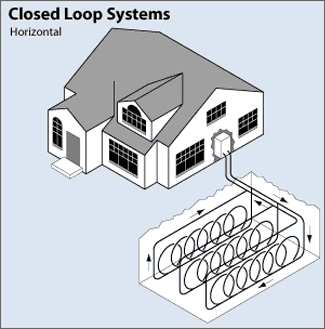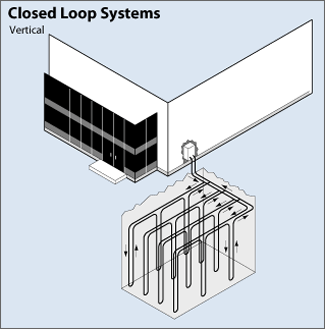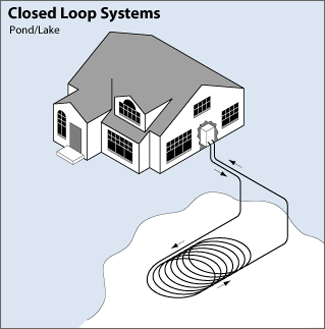Ground-Source Heat Pump Loops
There are several approaches to the outdoor portion of ground-source heat pump (GSHP) systems, and certain approaches may be more feasible depending on the land area and geology of the site.
If you have questions about GSHPs, contact BED Energy Services.
Hiring the Right Team

Work with a qualified GSHP team to achieve optimal system performance, comfort, and energy savings. We can provide you with a list designers and installers.
Designers
Regardless of approach, diligent GSHP system design is crucial for successful operation and optimal energy performance.
Work with an experienced mechanical system designer to engineer the system to adequately serve building loads. BED can provide you with our list of qualified designers that are experienced with GSHP systems and projects in and around Burlington.
Avoid value engineering the wells or boreholes, as reducing quantity or size of wells or under-sizing loops can adversely affect system performance.
The indoor equipment for a GSHP system depends on the distribution system used to exchange heat with spaces in the building:
- Buildings with ductwork can circulate air to heat and cool spaces.
- Buildings with hydronic distribution and terminal equipment can circulate warm water for radiant heating and chilled water for cooling.
- Fan coil units are commonly used to provide cooling; chilled beams can also be used.
Drillers
Start your GSHP install by working with a water well driller that is experienced with ground-source heat pump systems. Work with a seasoned geothermal well driller to understand your site’s geology and groundwater flows to determine if an open loop approach is feasible, as it may be more cost-effective than a closed loop system.
Ask for these credentials:
- National Ground Water Association vertical closed loop driller certification and/or
- IGSHPA loop installer accreditation, as well as
- References from past projects
- Contact information for system owner so you can ask about the system’s current performance
Pressure Testers
For closed loops, pressure testing is an extremely important stage of loop install; ensure that you work with a qualified pressure testing contractor that uses proper testing procedures to check the loop system for leaks. If a system is improperly pressure tested, leaks are a possibility and resolving leaks in buried piping can be very time- and labor-intensive, not to mention expensive.
Work with a service provider that is experienced with pressure testing closed loop ground-source heat pump piping. Request references from past projects so you may contact system owners to ask about leaks or other potential loop issues that can result from improper testing procedures.
Commissioning Agents
Whether a ground-source heat pump system is installed in a residential or commercial application, commissioning is crucial. Commissioning involves construction-phase design review and functional performance testing of equipment once construction is complete.
Commissioning your GSHP system will offer many benefits, and can save you money in the long run by avoiding expensive problems down the road:
- Design review and functional testing can avoid and resolve many design and construction issues that can arise in GSHP systems due to their complexity.
- During drilling and pressure testing activities, commissioning agents can ensure the loop is properly designed, installed, and does not leak refrigerant.
- Commissioning agents test the outdoor and indoor equipment as a system and can ensure proper equipment functionality and expected energy performance.
- Commissioning reports can give owners peace of mind and recourse for if issues do arise, so contractors can be held accountable for poor installations.
BED can provide you with our list of qualified commissioning agents that are experienced with GSHP systems and projects in and around Burlington.
Open Loop Designs
Open loop approaches are advantageous in that existing water well infrastructure can be shared with or repurposed for a GSHP system to reduce system uncertainty and drilling costs. Open loop approaches must consider the quality of the site’s groundwater to ensure pumps are not fouled by iron, manganese, silica, or calcite, which can degrade pump efficiency and performance.

Production / Injection Wells
This type of system circulates well water directly through the GSHP system by pumping water out of production wells, exchanging heat with the building, and reinjecting the water into the ground into injection wells to recharge the groundwater. This option is only practical where there is an adequate supply of clean groundwater. Production / injection well systems may be a few hundred to thousands of feet deep.
Standing Column Wells
Standing column well designs offer an open loop design that can be effective for sites with space constraints, as the same well is used for both production and injection. One or more wells circulate water through the GSHP system by drawing from the bottom of a standing column and returning water from the building to the top of the standing column.
During periods of peak heating and cooling, standing column systems can ‘bleed’ some of the water returning to the well from the building rather than reinjecting it all, which causes water from the surrounding aquifer to flow into the column. Bleed cycles can provide beneficial, additional capacity for the system by cooling the column during heat rejection and heating the column during heat extraction, which can reduce the required bore depth for a system.
Closed Loop Designs
Closed loop approaches use piping systems embedded in the ground or bodies of water to circulate an antifreeze solution through a heat exchanger inside a heat pump (or multiple heat pumps) serving a building. The antifreeze solution transfers heat to the ground-source heat pump’s refrigerant loop which provides heating or cooling to spaces in the building.

Horizontal Loops
These shallow loops are cost-effective for residential installations where land is not a constraint. Trenches are dug at least four feet deep for straight layouts; the “slinky” method of looping pipe can allow more pipe in a shorter trench, which cuts down on installation costs and makes horizontal installation possible in areas it might not be with conventional horizontal applications.

Vertical Loops
Large commercial buildings and schools often use deeper, vertical systems because the land area required for horizontal loops would be prohibitive. Boreholes are drilled about 20 feet apart and 100 to 400 feet deep, sometimes thousands of feet deep for large commercial systems. Two pipes are installed in the boreholes that are connected at the bottom with a U-bend to form a loop. The vertical loops are connected with horizontal pipe and buried in trenches. Piping loops are controlled in vaults, and vaults are connected to the heat pump(s) in the building to exchange heat for space conditioning.

Pond / Lake Loops
If the site has an adequate water body, a pond or lake loop may be a lower cost option. Piping is run underground from a building to the body of water and coiled into circles at depths of least eight feet to prevent freezing. Minimum design criteria for volume, depth, and quality of the water source should be considered.
